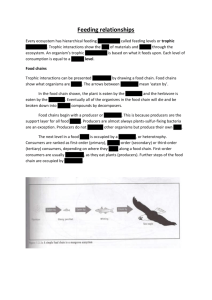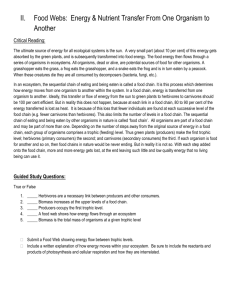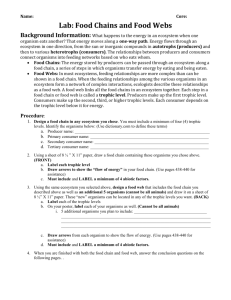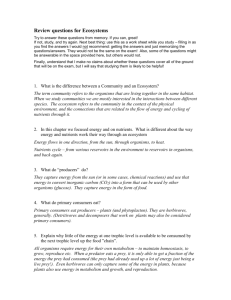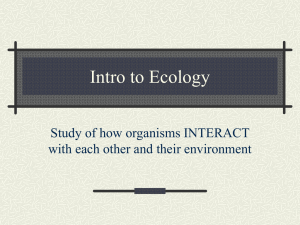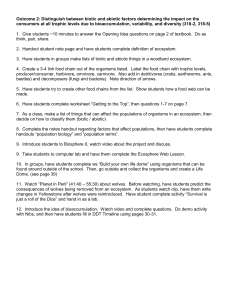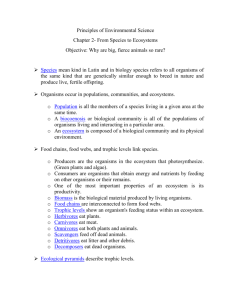printer-friendly version
advertisement
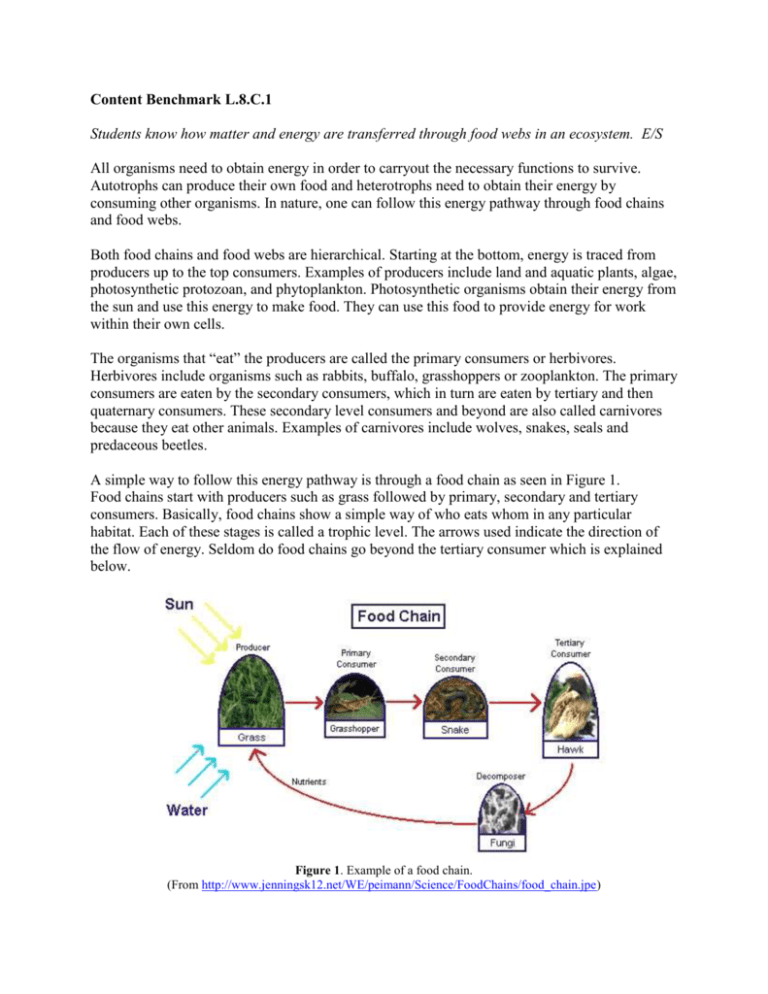
Content Benchmark L.8.C.1 Students know how matter and energy are transferred through food webs in an ecosystem. E/S All organisms need to obtain energy in order to carryout the necessary functions to survive. Autotrophs can produce their own food and heterotrophs need to obtain their energy by consuming other organisms. In nature, one can follow this energy pathway through food chains and food webs. Both food chains and food webs are hierarchical. Starting at the bottom, energy is traced from producers up to the top consumers. Examples of producers include land and aquatic plants, algae, photosynthetic protozoan, and phytoplankton. Photosynthetic organisms obtain their energy from the sun and use this energy to make food. They can use this food to provide energy for work within their own cells. The organisms that “eat” the producers are called the primary consumers or herbivores. Herbivores include organisms such as rabbits, buffalo, grasshoppers or zooplankton. The primary consumers are eaten by the secondary consumers, which in turn are eaten by tertiary and then quaternary consumers. These secondary level consumers and beyond are also called carnivores because they eat other animals. Examples of carnivores include wolves, snakes, seals and predaceous beetles. A simple way to follow this energy pathway is through a food chain as seen in Figure 1. Food chains start with producers such as grass followed by primary, secondary and tertiary consumers. Basically, food chains show a simple way of who eats whom in any particular habitat. Each of these stages is called a trophic level. The arrows used indicate the direction of the flow of energy. Seldom do food chains go beyond the tertiary consumer which is explained below. Figure 1. Example of a food chain. (From http://www.jenningsk12.net/WE/peimann/Science/FoodChains/food_chain.jpe) Figure 2. Comparison of a terrestrial and marine food chain. (From http://kentsimmons.uwinnipeg.ca/16cm05/1116/16ecosys.htm) To view a video that can be used in your classroom, select the Food Chain movie at National Geographic Kids found at http://magma.nationalgeographic.com/ngexplorer/0309/quickflicks/index.html In nature, organisms seldom have just one food source, nor are all animals either herbivores or carnivores. Some animals called omnivores because they eat both plants and animals. Therefore, food chains are a very simple way of viewing how energy passes within in a particular environment. A better way to view these eating relationships is by constructing a food web which contains a series of interconnecting food chains. We can identify a number of these interconnecting food chains by studying Figure 3. Figure 3. A typical food web. (From http://www.champaignschools.org/science/images/foodweb.gif) If we observe the food web in Figure 3, it is easy to identify several interlocking food chains. These include: Grass → Herbivorous insects → Spiders → Insectivorous birds → Snakes Grass → Herbivorous insects →Predaceous insects → Insectivorous birds → Hawks It can also be seen that organisms have more than one food source. In this food web, snakes eat insectivorous birds, toads, herbivorous and predaceous insects. Nor do organisms occupy just one feeding level. Depending upon which food chain we follow insectivorous birds can be classified as secondary or tertiary consumers. As energy passes through each trophic level, not all the energy is passed along to the next trophic level. The energy in the food we eat has four fates. 1. Cellular respiration provides energy for functions such as muscle movement or chemical reactions. 2. During cellular respiration up to 60% is lost as heat in some organisms. 3. The food we eat provides nutrients and energy for growth and repair. 4. Some of the food eaten cannot be digested and is eliminated as waste. For example, the wolf does not eat the bone or teeth of its prey. This food energy is lost to the organisms in the next trophic level. Figure 4. General Fate of Eaten Food. (From http://www.econguru.com/fundamentals_of_ecology/image/energy_flow.gif) Figure 5. Fate of food ingested by a caterpillar: In this example half of the energy from the plant tissue cannot be utilized. Much of this is the cellulose found in plant cells. (From http://kentsimmons.uwinnipeg.ca/16cm05/1116/54-10-EnergPartFoodChain-L.gif) Observe an animated explanation how energy is lost as organisms consume food at http://www.mhhe.com/biosci/esp/2001_gbio/folder_structure/ec/m3/s2/ecm3s2_6.htm In a majority of ecosystems, the energy used by living organisms comes ultimately from the sun. Photosynthetic organisms use this energy and convert it into useful energy for growth and maintenance. A very small percent (ranging from 1 to 3%) of the sunlight coming to the earth is actually used by organisms. About 50% percent of this energy goes for plant maintenance and the rest goes to form plant tissues. The energy in plant tissues is not available to the rest of the ecosystem until it is consumed or released into the surroundings by the activities of the consumers as shown in Figure 4. Although most life forms obtain their energy directly or indirectly from the sun, some organisms do not require sunlight to produce their own food. Chemosynthetic bacteria can survive in extreme environments such as deep sea hydrothermal vents. These organisms live at the bottom of the ocean where there is no sunlight, tremendous pressure, toxic chemicals, and temperatures near 100°C. On land, food chains are based upon photosynthesis, but in the deep sea, they are based upon chemosynthesis. The bacteria perform chemosynthesis by deriving energy from the breakdown of various compounds such as hydrogen sulfide. The chemosynthetic bacteria can support vast communities of life near the deep sea hydrothermal vents. To compare photosynthesis and chemosynthesis, visit http://www.divediscover.whoi.edu/vents/light.html. More information on deep ocean chemosynthetic bacteria can be found at these two sites http://pubs.usgs.gov/gip/dynamic/exploring.html http://www.algebralab.org/passage/passage.aspx?file=Biology_VolcanoVents.xml On average, only 10% of the energy taken in at one trophic level is passed on to the next. If we start with plants as 100%, plants will pass 10% along to the primary consumers (herbivores) which pass 1% along to secondary consumers (carnivores). The top carnivore or tertiary consumer (such as the hawks in Figure 1) would have to survive on 0.1% of the original energy coming from the plants. Also, at each trophic level bacteria and fungi will absorb and release some of this energy as they decompose dead or decaying organic material. Figure 6. An example of an energy pyramid. (From http://kentsimmons.uwinnipeg.ca/16cm05/1116/16ecosys.htm) With this loss of energy the number of organisms at each trophic level is also limited. Note the illustration below. Figure 7. A Pyramid of Number: As energy is lost from one trophic level to the next, less available energy translates into fewer organisms at the next higher trophic level. Generally, ecosystems are limited to 4 or 5 trophic levels for this reason. (From http://www.vtaide.com/png/foodchains.htm) The following quote provides a good illustration of how the energy loss in the ecosystem translates into the reduction of numbers at each trophic level. ...available energy should be turned into unavailable energy at each step of the food chain... In fact, this is exactly what happens. At each sage of the process, when the grasshopper eats the grass, and the frog eats the grasshopper, and the trout eats the frog, and so on, there is a loss of energy. In the process of devouring the prey, Says Miller, “about 80-90% of the energy is simply wasted and lost as heat to the environment.” Only between 10 and 20 percent of the energy that was devoured remains within the tissue of the predator for transfer to the next stage of the food chain. Consider for a moment the numbers of each species that are required to keep the next higher species from slipping toward maximum entropy. Three hundred trout are required to support one man for one year. The trout in turn, must consume 90,000 frogs, that must consume 27 million grasshoppers that live off of 1000 tons of grass. From Entropy into the Greenhouse World (1989) by Jeremy Rifkin, pg 69. At the end of this unit, teachers may incorporate a discussion on sustainability and apply this idea of energy loses to human populations and how we are to feed the world in the future. For example what are the advantages of a high plant/low meat diet? Some interesting facts about providing energy and nutrients to humans using a plant diet versus a meat diet can be found at http://www.veganvillage.co.uk/vegfam/feed.htm Content Benchmark L.8.C.1 Students know how matter and energy are transferred through food webs in an ecosystem. E/S Common misconceptions associated with this benchmark 1. Students have the misconception that energy can be recycled through an ecosystem. Unlike elements like carbon or nitrogen or molecules such as water, energy passes through the ecosystem on a one-way street. Most of the energy that is used by living organisms on earth ultimately comes from the sun in the form of radiant energy. It is used by plants (through photosynthesis) to produce food. Cell respiration converts this food into useful energy in the form of ATP, but most is lost as heat. In fact, about 60% of the energy in a glucose molecule is lost this way. Heat is the ultimate fate of all energy in ecosystems. As heat, energy could not keep our planet “alive”. Energy is not recycled, but must continually be supplied to our planet. The second law of thermodynamics explains this process. Heat transfer flows in one direction, from hot to cold and not the reverse. As energy passes through the ecosystem, less and less is available to living organisms at each succeeding trophic level in a useful form. To learn more about the passage of energy in the ecosystem go to: http://www.uwsp.edu/cnr/WCEE/keep/Mod1/Flow/foodchains.htm 2. Students have the misconception that energy accumulates as it passes through the ecosystem. Rather than accumulating the reverse is true. As available food passes from one trophic level to the next, energy is lost in the form of heat, waste or undigested food and the energy needed to maintain normal metabolic activities. Energy that is passed on is represented in the body tissues of organisms at each tropic level. As discussed earlier, as much as 90% of the energy in one trophic level is lost and therefore unavailable to the next higher trophic level. To learn more about the passage of energy through the ecosystem go to: http://www.mhhe.com/biosci/esp/2001_gbio/folder_structure/ec/m3/s2/ecm3s2_6.htm 3. Students have the misconception that there are more herbivores because they have more offspring. Being primary consumers, herbivores are often more common because they have more available energy for all of life’s processes. This translates in a greater ability to produce more offspring. As we move up the food chain organisms have less energy for survival and therefore produce fewer offspring that survive. To learn more about numbers of organisms at each trophic level, teachers can view the website below. This site gives a more advanced view and is not intended for students. http://users.rcn.com/jkimball.ma.ultranet/BiologyPages/F/FoodChains.html 4. Students have the misconception that organisms higher up on a food web are predators to everything below it. Each organism occupies a particular niche or role in the ecosystem. Herbivores are specialists and what they eat has a limited range. Some are grazers eating grasses while others are browsers which eat leaves. However, animals at the higher trophic levels do have a wider range of prey. Nevertheless, they do not eat everything below them on a food web. This misconception and outside references can be found at: http://ecomisconceptions.binghamton.edu/energyflow.htm 5. Students have the misconception that carnivores can exist in a plant free world if all of their prey produces enough offspring. Without plants at the bottom of the food web, consumers would not be able to obtain any energy for survival. Without these organisms, predators at the top of the food web would have nothing to feed upon. The presence of plants or other producers such as the phytoplankton in the oceans are necessary for the establishment and continued existence of any food web. Refer to MS TIPS Benchmark L.8.B.2 for a discussion of the importance of photosynthesis. This misconception and others related to it can be found at: http://homepage.mac.com/vtalsma/syllabi/2943/handouts/misconcept.html#ecosystems Content Benchmark L.8.C.1 Students know how matter and energy are transferred through food webs in an ecosystem. E/S Sample Test Questions Hawk Fox Snake Mouse Frog Beetle Grasshopper Fungus Grass 1. In the food web above which organism would be termed an omnivore? a. Grasshopper b. Frog c. Mouse d. Fungus 2. In the food web above which organism would be termed a herbivore? a. Beetle b. Frog c. Hawk d. Snake 3. In the food web above which organism would have the largest population? a. Fox b. Mouse c. Frog d. Grasshopper 4. In the food web above hawks have the smallest population because a. they are birds b. they only have two different organisms to eat. c. less energy is available for them to carryout life functions. d. they have few offspring. 5. Which of the following is NOT one of the ways energy is lost to other organisms as it passes through a food chain? a. cellular respiration b. via growth and repair c. as heat d. as waste material 6. Organisms in the food web that are responsible for returning matter back to the environment are the a. herbivores b. carnivores c. omnivores d. decomposers Content Benchmark L.8.C.1 Students know how matter and energy are transferred through food webs in an ecosystem. E/S Answers to Sample Test Questions 1. (c) 2. (a) 3. (d) 4. (c) 5. (b) 6. (d) Content Benchmark L.8.C.1 Students know how matter and energy are transferred through food webs in an ecosystem. E/S Intervention Strategies and Resources The following is a list of intervention strategies and resources that will facilitate student understanding of this benchmark. 1. Interactive Food Chains and Food Webs Websites: At C.o.o.l Projects Food Web Game students can create a marine food web and be scored on their ability to do so. If the teacher feels this is too advanced, their students can complete it as a “class project”. http://www.blue-iceberg.com/rutgersfoodweb/# Food Webs is an interactive activity whereby students can identify the trophic level of selected organisms found in one of four different habitats. The habitats include the Australian and African grasslands; the Antarctic; and the seashore. http://www.gould.edu.au/foodwebs/kids_web.htm At Crickweb.co.uk students have a choice of creating food chains in three different habitats including woodlands, river, and seashore. Very simple. http://www.crickweb.co.uk/assets/resources/flash.php?&file=foodchains Fun with Food Webs is a web-base module that allows students to construct simple food webs in a meadow, pond, or the Arctic. http://www.harcourtschool.com/activity/food/food_menu.html 2. At Puzzle Page student are asked to take a 10 question quiz on food chains and related terminology. Students are scored as they proceed with the questions. Explanations are given for each question in this quiz. Select Puzzles about food chains. http://www.zephyrus.co.uk/puzzlesmaster.html 3. Energy Flow in an Ecosystem Animation from McGraw Hill Teachers can use this animation to help explain the flow of energy in the ecosystem. http://www.mhhe.com/biosci/esp/2001_gbio/folder_structure/ec/m3/s2/ecm3s2_6.htm 4. Saved by a Shark Lesson from National Geographic Xpeditions This lesson will depict the effect that sharks have in the Caribbean coral reef system and will show students how over-fishing of sharks has a ripple effect on the marine ecosystem. Students will learn about the balance in the reef ecosystem among sharks and other carnivorous fish, their prey, and algae. Students will see that predatory behavior is not inherently negative and that predators are an important part of a balanced ecosystem. http://www.nationalgeographic.com/xpeditions/lessons/07/g68/noaashark.html 5. Owl Pellet Dissection Resources An activity that many teachers do and is enjoyed by students is the owl pellet dissection. In this activity, students discover the amount and wide range of organisms eaten by owls. Numerous webpages can be found for this activity. A short list is included here. Lesson plans and/or data sheets for this activity can be found at these two sites: http://naturalsciences.sdsu.edu/ta/classes/lab2.2/lab2.2.html http://www.eagle-bluff.org/Owl%20Pellets.pdf http://www.biologycorner.com/worksheets/owlpellet.html Kidwings offers a virtual dissection of an owl pellet along with flash movie showing how to conduct this activity with actual owl pellets. http://www.kidwings.com/owlpellets/ A list of owl pellet webpages can be found at http://outreach.rice.edu/~dgabby/science/2002/owl_pellets/
